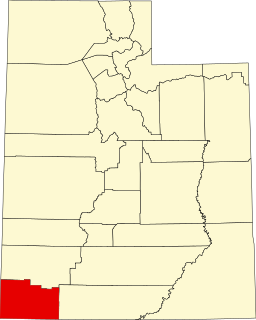Boyter, James, Shop | |
 | |
| Location | 50 W. 200 North, Beaver, Utah |
|---|---|
| Coordinates | 38°16′38″N112°38′29″W / 38.27722°N 112.64139°W Coordinates: 38°16′38″N112°38′29″W / 38.27722°N 112.64139°W |
| Area | less than one acre |
| Built | 1911 |
| Built by | Boyter, James |
| MPS | Beaver MRA |
| NRHP reference # | 83004395 [1] |
| Added to NRHP | April 15, 1983 |
The James Boyter Shop, at 50 W. 200 North in Beaver, Utah, was built in 1911. It was listed in the National Register of Historic Places in 1983. [1]

Beaver is a city in eastern Beaver County, Utah, United States. It is also serves as the county seat. The population was 3,112 at the 2010 census. It is the county seat of Beaver County.

The National Register of Historic Places (NRHP) is the United States federal government's official list of districts, sites, buildings, structures and objects deemed worthy of preservation for their historical significance. A property listed in the National Register, or located within a National Register Historic District, may qualify for tax incentives derived from the total value of expenses incurred in preserving the property.
It was originally used as a shop for James Boyter's monument-carving. Boyter was a sculptor and carved headstones for cemeteries in the area, working with pink stone tuff and white marble brought from the mining town of Newhouse, Utah. His works often featured lambs. He also was a stonemason and helped his brother Alexander Boyter in construction work. [2]

Tuff, also known as volcanic tuff, is a type of rock made of volcanic ash ejected from a vent during a volcanic eruption. Following ejection and deposition, the ash is compacted into a solid rock in a process called consolidation. Tuff is sometimes erroneously called "tufa", particularly when used as construction material, but properly speaking, tufa is a limestone precipitated from groundwater. Rock that contains greater than 50% tuff is considered tuffaceous.

Newhouse is a ghost town located on the eastern edge of the Wah Wah Valley in Beaver County, Utah, United States. A silver mining town based on the Cactus Mine on the western slopes of the San Francisco Mountains, Newhouse was smaller and quieter than Frisco, 5 miles (8.0 km) to the southeast.












